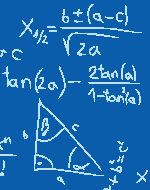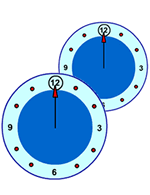
Relativity Myths & Ideas

Speculation
Despite the success of Einstein's theories, there are still doubts as to their philosophic relevance. This is because the theories may be regarded as a factual description of the universe, or as a mathematical model of how the universe behaves. The two are not synonymous. For example, geocentricity (the idea that the Earth is the centre of the universe) was not a factual description of the universe, but it worked as a mathematical model. It was replaced by heliocentricity (the idea that the Earth revolves around the Sun). But even that is only part of the truth, because our solar system revolves around the centre of the Milky Way galaxy. So this section presents brief discussions of:

String Theory
In string theory, as in classical physics, matter is composed of molecules which are made up of atoms, in which electrons orbit the nucleus (which is composed of protons and neutrons). However, string theory then goes on to propose that electrons are composed of one dimensional building blocks, "strings", and that the protons and neutrons are composed of quarks which are also composed of "strings". Hence the fundamental building blocks from which all matter is composed are one dimensional extended objects, "strings".
String theory suggests that the universe has more than the conventional four dimensions (three spatial and one time). However there is no consensus over how many dimensions there are. In its original form there were five variants of the theory which had ten dimensions, and one variant (bosonic) with twenty-six dimensions. Since then the M-theory has proposed that there are eleven dimensions. The M-theory was expected to unify the other theories, but this process is not complete.
A major weakness of string theory is that it has not provided any experimentally testable predictions. Hence it cannot be falsified (i.e. proven to be wrong). The ability to be proven to be wrong is a key element in a theory being considered scientific. String theory has the potential to be the "theory of everything" (i.e. an unified description of the universe) but, at present, it is a collection of highly speculative, incomplete and unproven mathematical models. Therefore some people question the inclusion of string theory, in its present guise, as science at all.
A more technical introduction to string theory may be found here.

Absolute Simultaneity
In the Myths section I have questioned whether differences in simultaneity are real, based on the fact that they do not, and cannot, have any effect on the outcome of events. However, recently, a strong argument against differences in simultaneity has been put forwards by Dr. John Field, a former researcher at CERN.
He has derived the Lorentz transformation by a method which does not require, or suggest, that differences in simultaneity arise. Similarly, it does not invoke differences in physical dimensions or distances. In his words:
"It is demonstrated that the measured spatial separation of two objects, at rest in some inertial frame, is invariant under space-time transformations. This result holds in both Galilean and Special Relativity. A corollary is that there are no 'length contraction' or associated 'relativity of simultaneity' effects in the latter theory."
Instead he suggests that what is actually taking place is a difference in velocities. This suggests that the "Reciprocity Principle" does not apply to Special Relativity. Note: The Reciprocity Principle is the idea that if object A has a velocity of v with respect to the rest frame of object B, then object B has a velocity of -v in A's rest frame. This is true in Galilean Relativity, but it is not so in Field's interpretation of Special Relativity.
The potential impact of this on our understanding of the universe could be significant. As differences in simultaneity have never been observed experimentally, their only justification lay in the fact that they formed an explicit part of Einstein's derivation of the Lorentz transformation. Take that away, and there remains no reason to suggest they exist at all.
A fuller discussion of John Field's ideas is presented here, together with links to a number of his papers...

Physics Myths and Physics Facts
Dr. Thomas Smid, who has a PhD in astronomy, is critical of a number of theories in classical and modern physics. In his web site Physics Myths and Physics Facts he describes them as "some important theoretical concepts in physics where the latter can be shown to be either misleading, inadequate, erroneous or outright logically flawed". His objection to relativity is founded on the logical absurdity of defining the measurement of time and space non-linearly. In the section titled "Speed of Light and Theory of Relativity" he says...
"It should be obvious however that this procedure is no less mathematically flawed than having for instance the inconsistent 'equation' 1=2, multiplying the right hand side by a factor k, i.e. 1=k.2, and then saying that the equation is consistent for k=1/2 ...it is equivalent to using your own customized measuring stick when, let's say, a certain job requires you to be 180cm tall but you measure only 150cm; you can re-scale your measuring units so that it shows 180cm, but it is obvious that this is an incorrect and illegal procedure."
A fuller explanation of Thomas Smid's ideas is presented on his web site Physics Myths and Physics Facts...

CICS
The idea of complete and incomplete co-ordinate systems (CICS) was originated by Steve Bryant, and is published on his web site "Relativity Challenge". His definitions of the co-ordinate systems are:
"A Complete Coordinate System is one in which the phenomena under observation (or its associated travel medium) is contained within the coordinate system and moves with it at velocity v."
"An Incomplete Coordinate System is one in which the phenomena under observation (or its associated travel medium) is not completely contained within the coordinate system and does not move with it at velocity v."
Bryant suggests that the result of the Michelson-Morley experiment was apparently negative because the results were analysed as if the experiment had taken place in a complete co-ordinate system. When re-interpreted as being an incomplete co-ordinate system, the motion of the Earth with respect to the luminiferous aether or light medium had been detected. Hence there is no need to assume the spatial contraction and time dilation, as described by the Lorentz transformation, which is central to Einstein's Special and General Theories of Relativity.
A fuller explanation of CICS may be found on the Relativity Challenge web site.

Simultaneity-Time
Simultaneity-time is a conceptual framework that was first published in 2005. It is based on the observation that the empirical evidence shows that the speed of light is constant in the rest frame of the equipment used to measure it, whereas Einstein's theory assumes that the speed of light is constant in all other frames of reference as well. Thus the empirical evidence does not directly support Einstein's assumption.
So a thought experiment is used to illustrate the effects of taking the speed of light as being constant in the rest frame of the object it is approaching, without making any assumptions as to its value in other frames of reference. This identifies the "velocity effect".
The mathematical relationship between the actual and perceived distances between an observer and a distant object is derived. This shows that the effect differs from the Lorentz transformation. Hence it leads to a different conceptual framework, simultaneity-time.
The simultaneity-time scenario is conceptually based on Newtonian relativity, but is extended to accommodate the effects of the fixed and finite speed of light. It also provides an explanation of how light can behave in the manner it does in a scenario that is otherwise Newtonian.
A fuller explanation of simultaneity-time may be found on the Simultaneity-Time web site.
